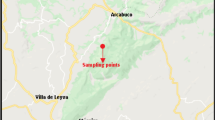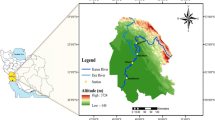Abstract
Total dissolved solids (TDS) concentration, as an essential variable in evaluating the quality of drinking and agricultural water, represents water body salinity. In a river system, high TDS concentration has negative impacts on human health and crops consuming water. Since anions and cations affect the TDS value, identifying a relationship between these variables and TDS can help predict and monitor river quality. This research investigates the Gaussian process regression (GPR) model capabilities as a data-driven model to capture the relationship and estimates the TDS value in the Tajan River watershed in Northern Iran. Monthly anions and cations measured over 16 years including bicarbonate (\({\text{HCO}}_{{3}}^{ - }\)), carbonate (\({\text{CO}}_{{3}}^{{2 - }}\)), sulfate (\({\text{SO}}_{{4}}^{{2 - }}\)), chloride (\({\text{Cl}}^{ - }\)), calcium (\({\text{Ca}}^{{2 + }}\)), magnesium (\({\text{Mg}}^{{2 + }}\)), sodium (\({\text{Na}}^{ + }\)), and potassium (\({\text{K}}^{ + }\)) are considered as the predictor variables. Five GPR kernel functions are applied in the modeling, and their efficiency is evaluated using four statistics: the coefficient of determination (R2), Mean absolute error (MAE), Mean squared error (MSE), and Nash–Sutcliffe efficiency (NSE). Also, the performance of the proposed method is assessed by comparing it to the Artificial neural network (ANN) model, as an efficient and popular prediction model. The results reveal that the GPR model with the rational quadratic kernel function performed better in terms of performance criteria (R2 = 0.9836).












Similar content being viewed by others
Availability of data and material
The data are gathered by Waresh Environment and Energy Research Institute, Sari City, Iran. Since the codes are used in next research, it is not possible to be presented by the authors.
References
Aazami J, Esmaili-Sari A, Abdoli A, Sohrabi H, Van den Brink PJ (2015) Monitoring and assessment of water health quality in the Tajan River, Iran using physicochemical, fish and macroinvertebrates indices. J Environ Health Sci Eng 13(1):29. https://doi.org/10.1186/s40201-015-0186-y
Abba SI, Hadi SJ, Abdullahi J (2017) River water modelling prediction using multi-linear regression, artificial neural network, and adaptive neuro-fuzzy inference system techniques. Procedia Comput Sci 120:75–82. https://doi.org/10.1016/j.procs.2017.11.212
Alizadeh Z, Yazdi J, Kim JH, Al-Shamiri AK (2018) Assessment of machine learning techniques for monthly flow prediction. Water 10(11):1676. https://doi.org/10.3390/w10111676
Alizadeh Z, Yazdi J, Mohammadiun S, Hewage K, Sadiq R (2019) Evaluation of data driven models for pipe burst prediction in urban water distribution systems. Urban Water J 16(2):136–145. https://doi.org/10.1080/1573062X.2019.1637004
Al-Mukhtar M, Al-Yaseen F (2019) Modeling water quality parameters using data-driven models, a case study Abu-Ziriq marsh in south of Iraq. Hydrology 6(1):24. https://doi.org/10.3390/hydrology6010024
Beale M, Hagan M, Demuth H (2010) Neural network toolbox user’s guide. The MathWorks Inc., Natick
Cameron AC, Windmeijer FA (1997) An R-squared measure of goodness of fit for some common nonlinear regression models. J Econom 77(2):329–342. https://doi.org/10.1016/S0304-4076(96)01818-0
Chen JC, Chang NB, Shieh WK (2003) Assessing wastewater reclamation potential by neural network model. Eng Appl Artif Intell 16(2):149–157. https://doi.org/10.1016/S0952-1976(03)00056-3
Dawson CW, Abrahart RJ, See LM (2007) HydroTest: a web-based toolbox of evaluation metrics for the standardised assessment of hydrological forecasts. Environ Model Softw 22(7):1034–1052. https://doi.org/10.1016/j.envsoft.2006.06.008
Fallah M, Farajzadeh M (2008) The assessment of land use and land cover change on abiotic characterises of Tajan River. Iran Iran J Geogr Res 64:89–104 (In Persian)
Farjoudi SZ, Moridi A, Sarang A, Lence BJ (2021) Application of probabilistic bankruptcy method in river water quality management. Int J Environ Sci Technol. https://doi.org/10.1007/s13762-020-03046-8
Gordillo G, Morales-Hernández M, García-Navarro P (2020) Finite volume model for the simulation of 1D unsteady river flow and water quality based on the WASP. J Hydroinf 22(2):327–345. https://doi.org/10.2166/hydro.2019.080
Grbić R, Kurtagić D, Slišković D (2013) Stream water temperature prediction based on Gaussian process regression. Expert Syst Appl 40(18):7407–7414. https://doi.org/10.1016/j.eswa.2013.06.077
Haghiabi AH, Nasrolahi AH, Parsaie A (2018) Water quality prediction using machine learning methods. Water Qual Res J 53(1):3–13. https://doi.org/10.2166/wqrj.2018.025
Kadam AK, Wagh VM, Muley AA, Umrikar BN, Sankhua RN (2019) Prediction of water quality index using artificial neural network and multiple linear regression modelling approach in Shivganga River basin, India. Model Earth Syst Environ 5(3):951–962. https://doi.org/10.1007/s40808-019-00581-3
Khadr M, Elshemy M (2017) Data-driven modeling for water quality prediction case study: the drains system associated with Manzala Lake, Egypt. Ain Shams Eng J 8(4):549–557. https://doi.org/10.1016/j.asej.2016.08.004
Kopsiaftis G, Protopapadakis E, Voulodimos A, Doulamis N, Mantoglou A (2019) Gaussian process regression tuned by bayesian optimization for seawater intrusion prediction. Comput Intell Neurosci. https://doi.org/10.1155/2019/2859429
Lal A, Datta B (2018) Genetic programming and gaussian process regression models for groundwater salinity prediction: machine learning for sustainable water resources management. In: 2018 IEEE conference on technologies for sustainability (SusTech). IEEE. https://doi.org/10.1109/SusTech.2018.8671343
Maier HR, Jain A, Dandy GC, Sudheer KP (2010) Methods used for the development of neural networks for the prediction of water resource variables in river systems: current status and future directions. Environ Model Softw 25(8):891–909. https://doi.org/10.1016/j.envsoft.2010.02.003
McCulloch WS, Pitts W (1943) A logical calculus of the ideas immanent in nervous activity. Bull Math Biophys 5(4):115–133. https://doi.org/10.1007/BF02478259
Mishra BK, Regmi RK, Masago Y, Fukushi K, Kumar P, Saraswat C (2017) Assessment of Bagmati river pollution in Kathmandu valley: scenario-based modeling and analysis for sustainable urban development. Sustain Water Qual Ecol 9:67–77. https://doi.org/10.1016/j.swaqe.2017.06.001
Nash JE, Sutcliffe JV (1970) River flow forecasting through conceptual models part I—a discussion of principles. J Hydrol 10(3):282–290. https://doi.org/10.1016/0022-1694(70)90255-6
Nemati S, Fazelifard MH, Terzi Ö, Ghorbani MA (2015) Estimation of dissolved oxygen using data-driven techniques in the Tai Po River, Hong Kong. Environ Earth Sci 74(5):4065–4073. https://doi.org/10.1007/s12665-015-4450-3
Rasmussen CE (2003) Gaussian processes in machine learning. In summer school on machine learning. Springer, Berlin, pp 63–71
Roushangar K, Shahnazi S (2020) Prediction of sediment transport rates in gravel-bed rivers using Gaussian process regression. J Hydroinf 22(2):249–262. https://doi.org/10.2166/hydro.2019.077
Saiidi M, Karbasi AR, Bidhandi GR, Mehrdadi N (2007) The effect of human activity on the accumulation of heavy metals in Tajan River in Mazandaran Province. J Environ Stud 32(40):41–50 (In Persian)
Salami ES, Ehteshami M (2015) Simulation, evaluation and prediction modeling of river water quality properties (case study: Ireland Rivers). Int J Environ Sci Technol 12(10):3235–3242. https://doi.org/10.1007/s13762-015-0800-7
Salari M, Shahid ES, Afzali SH, Ehteshami M, Conti GO, Derakhshan Z, Sheibani SN (2018) Quality assessment and artificial neural networks modeling for characterization of chemical and physical parameters of potable water. Food Chem Toxicol 118:212–219. https://doi.org/10.1016/j.fct.2018.04.036
Sattari MT, Farkhondeh A, Abraham JP (2018) Estimation of sodium adsorption ratio indicator using data mining methods: a case study in Urmia Lake basin, Iran. Environ Sci Pollut Res 25(5):4776–4786. https://doi.org/10.1007/s11356-017-0844-y
Sharma D, Kansal A, Pelletier G (2017) Water quality modeling for urban reach of Yamuna river, India (1999–2009), using QUAL2Kw. Appl Water Sci 7(3):1535–1559. https://doi.org/10.1007/s13201-015-0311-1
Singh B (2020) Prediction of the sodium absorption ratio using data-driven models: a case study in Iran. Geol Ecol Landsc 4(1):1–10. https://doi.org/10.1080/24749508.2019.1568129
Zhao J, Guo H, Han M, Tang H, Li X (2019) Gaussian process regression for prediction of sulfate content in lakes of China. J Eng Technol Sci 51(2):198–215
Funding
This research is not supported by any grant.
Author information
Authors and Affiliations
Contributions
Conducting the research and writing the manuscript are done equally by both authors.
Corresponding author
Ethics declarations
Conflict of interest
The authors declare that they have no conflict of interest.
Additional information
Publisher's Note
Springer Nature remains neutral with regard to jurisdictional claims in published maps and institutional affiliations.
Rights and permissions
About this article
Cite this article
Zare Farjoudi, S., Alizadeh, Z. A comparative study of total dissolved solids in water estimation models using Gaussian process regression with different kernel functions. Environ Earth Sci 80, 557 (2021). https://doi.org/10.1007/s12665-021-09798-x
Received:
Accepted:
Published:
DOI: https://doi.org/10.1007/s12665-021-09798-x




